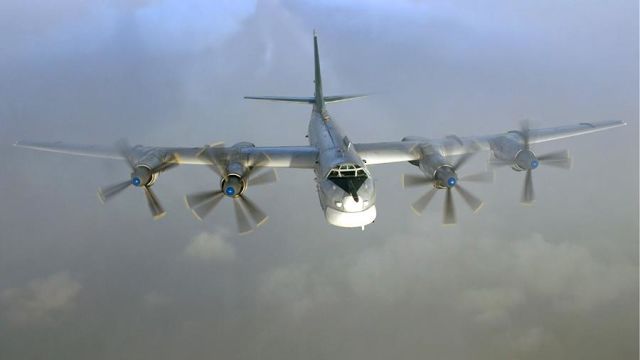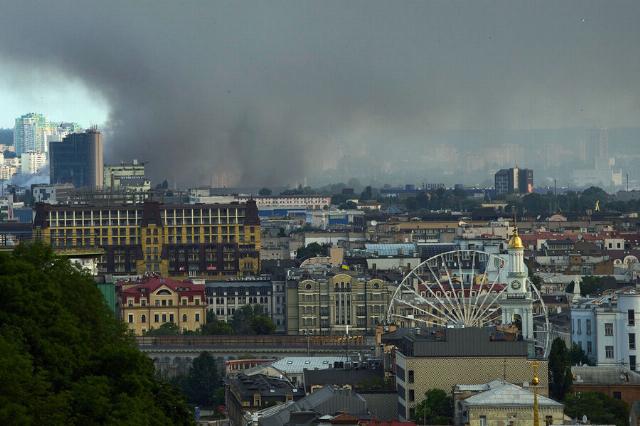Ministry of Defense: Russian Armed Forces attacked military enterprises and facilities in Kiev at night
On June 10, one of the most powerful strikes was carried out against the facilities of the capital of Ukraine. In addition to Kiev, targets in the Odessa, Chernihiv and Dnipropetrovsk regions were attacked. According to the Russian Defense Ministry, the strike was carried out against military enterprises and facilities. Is it possible to talk about the Russian response to Kiev's attack on airfields, the military observer of Gazeta argues.Ru", retired Colonel Mikhail Khodarenok.
According to the Ukrainian Armed Forces, on the night of Monday to Tuesday, June 10, the Russian Armed Forces attacked Ukraine with 315 Geranium-type unmanned aerial vehicles and UAV simulators from five directions. In addition, seven missiles manufactured by the DPRK and Russia were attacked: two ballistic KN-23 and five cruise Iskander-K missiles. The main blow was inflicted on Kiev, as well as Odessa.
According to the General Staff of the Armed Forces of Ukraine, as of 9:00 a.m., 284 enemy air attack weapons were allegedly neutralized, 220 were shot down by fire, 64 were lost locationally: 213 Shahed-type enemy UAVs (drones of other types) were shot down by fire, 64 were locally lost/suppressed by electronic warfare; 2 KN-23 ballistic missiles; 5 cruise missiles "Iskander-K".
According to the Russian Defense Ministry, Russian aircraft and missile units launched a group strike with precision weapons against targets in Ukraine.
"Last night, the Armed Forces of the Russian Federation launched a group strike with precision weapons and unmanned aerial vehicles against enterprises of the aviation, missile, armored and shipbuilding industries of Ukraine in Kiev, command posts and locations of the Armed Forces of Ukraine, concentrations of weapons and military equipment of Ukrainian formations," the military department said.
A series of blows
It should be noted that this is far from the first strike by the Russian Armed Forces against targets on the territory of Ukraine in recent times. It is quite possible to talk about a series of attacks, which (of course, to some extent) are already beginning to resemble an air operation with new means of attack.
Operational construction of means of air attack (SVN) of the Russian Armed Forces (and altitude-time schedule) it differs from blow to blow and, apparently, includes several echelons.
It can be assumed that operational and tactical ballistic missiles usually operate in the first echelon. In the second echelon are unmanned aerial vehicles. The third echelon includes sea- and air-launched cruise missiles from submarines and surface ships in the Black Sea and from Tu-95MS bombers launched over the Caspian Sea, respectively.
 |
| The Tu-95MS strategic bomber-missile carrier. |
| Source: Photo: commons.wikimedia.org/Sergey Krivchikov |
All three echelons (their number may vary from strike to strike) are divided into strike groups, groups of fire suppression of enemy air defense systems, demonstration groups, and groups of cover from fighter aircraft of the Ukrainian Air Force.
The idea of such an air operation is most likely to involve strikes against targets on the territory of Ukraine in several stages. At the first stage, the main targets of strikes are primarily elements of the Ukrainian air defense system, airfields based on combat aircraft, command posts and control points of all levels in order to disorganize command and control, communications centers, as well as creating favorable conditions for subsequent air attacks by the Armed Forces of the Russian Federation.
The purpose of the subsequent stages is to strike at enterprises of the military-industrial complex, ammunition and fuel depots, and communications. And all of the above, apparently, has been largely implemented recently.
Why did the Ukrainian air defense fail
The Ukrainian air defense system at this stage, despite the cheerful and optimistic reports of the General Staff of the Armed Forces of Ukraine, frankly failed to cope with the tasks set. This happened for the following reasons.
The capabilities of the Armed Forces of Ukraine's electronic intelligence forces and facilities provide a continuous radar field over the territory of the country with a lower border, most likely only a few kilometers. A low-altitude field with a lower limit of 60-100 meters, there is every reason to believe, is not provided even in the areas of the most important facilities.
The small depth of the AFU air defense radar field, combined with significant problems in processing intelligence information, leads to a significant delay in the issuance of target designation data. Among other things, experts note the low capabilities of the AFU's electronic air defense systems to detect tactical and cruise missiles.
Anti-aircraft missile cover of even the most important facilities in Ukraine is ineffective due to the insufficient combat strength of the air defense systems of the Armed Forces of Ukraine. The insufficient number of anti-aircraft guided missiles at the launching positions of divisions and batteries has an extremely negative effect on repelling the strikes of the Russian Armed Forces.
There is every reason to believe that the intensity of air strikes by the Russian Armed Forces will only increase in the near future. And it is quite possible that the main blow (in response to the attacks of the Ukrainian Armed Forces UAVs on Russian Long-range aviation airfields) More to come.
The reason to think so is given by the fact that despite all the power and effectiveness of the previous strikes of the Russian Armed Forces against targets on the territory of Ukraine, they still had insufficient moral effect for the broad masses of the people in Russia. Therefore, it is quite possible that the required ingenuity and initiative of the planners of such attacks will be shown in the near future.
The opinion of the author may not coincide with the position of the editorial board.
Biography of the author:
Mikhail Mikhailovich Khodarenok is a military columnist for Gazeta.Ru", retired colonel.
He graduated from the Minsk Higher Engineering Anti-Aircraft Missile School (1976), the Military Air Defense Command Academy (1986).
Commander of the S-75 anti-aircraft missile division (1980-1983).
Deputy commander of the anti-aircraft missile regiment (1986-1988).
Senior Officer of the General Staff of the Air Defense Forces (1988-1992).
Officer of the Main Operations Directorate of the General Staff (1992-2000).
Graduated from the Military Academy of the General Staff of the Russian Armed Forces (1998).
Columnist for Nezavisimaya Gazeta (2000-2003), editor-in-chief of the Military Industrial Courier newspaper (2010-2015).
Mikhail Khodarenok

